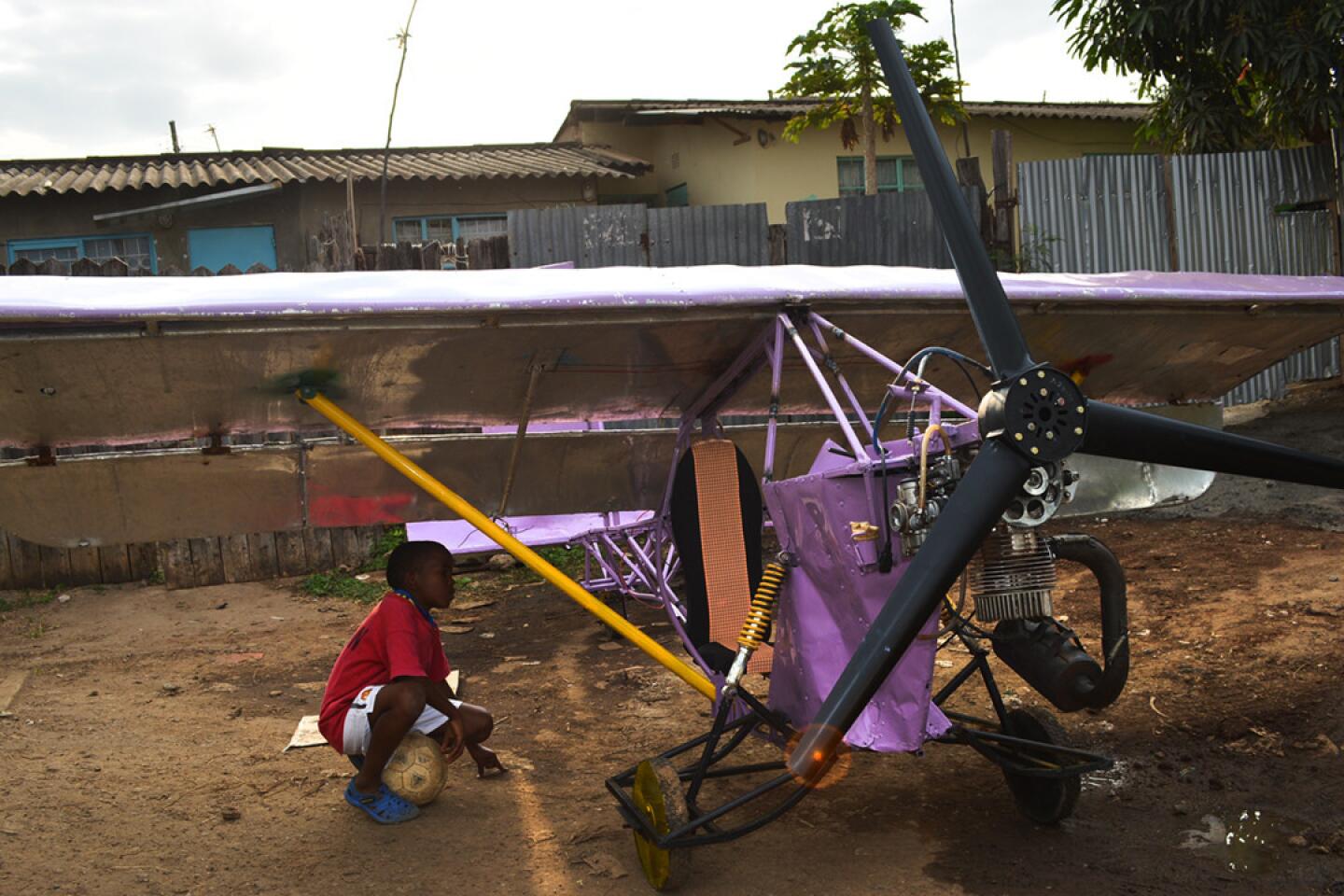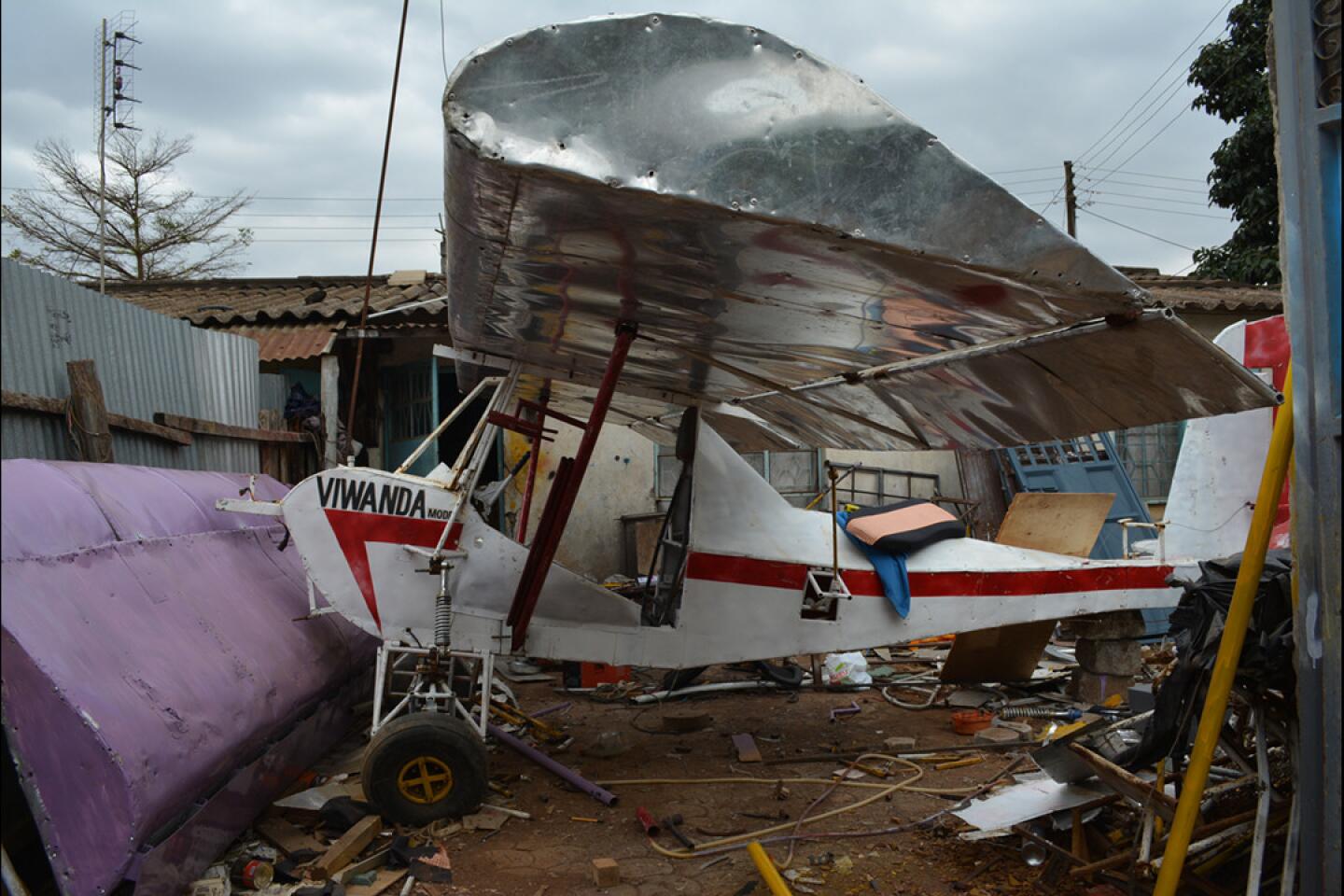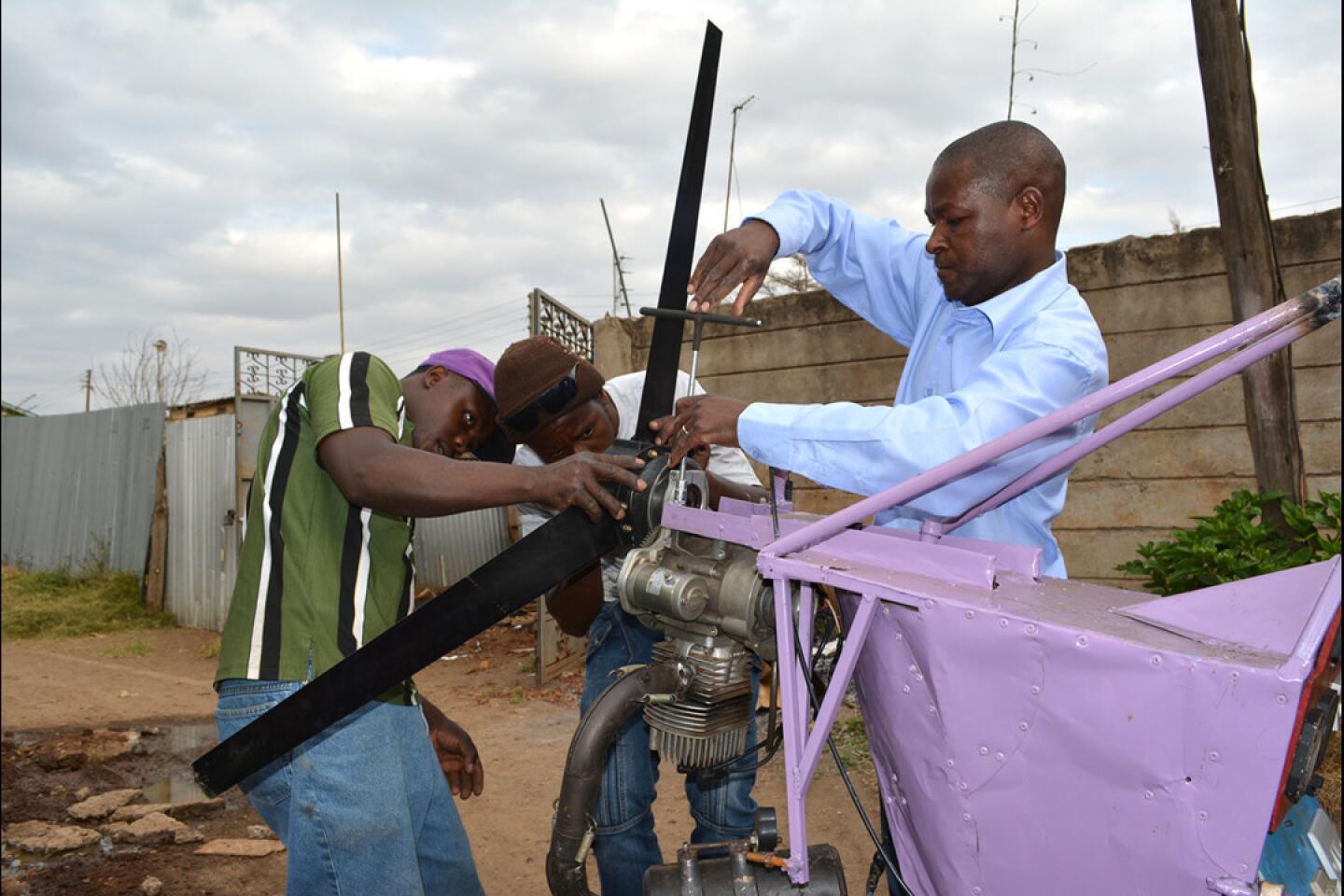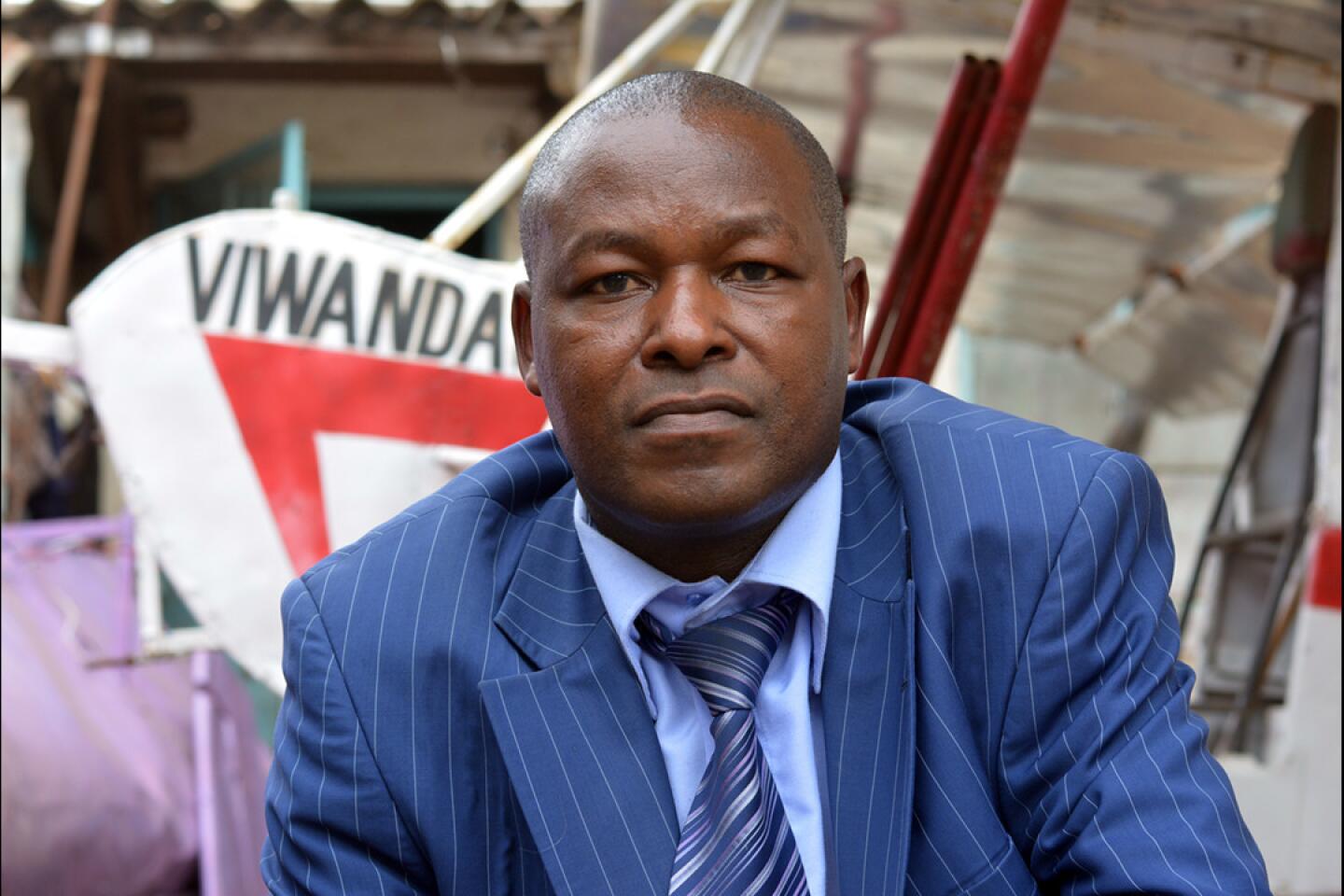Great Read: Backyard plane builder in Kenya hopes his 14th try will take flight
- Share via
Reporting from Nairobi, Kenya — As he climbed into the plane he’d built in his tiny Nairobi backyard, even Gabriel Nderitu was doubtful that the ungainly machine, with a 450-pound car engine bolted onto the front and a 7-foot hand-carved wooden propeller, would get him airborne.
When he revved the motor of Project One, as he called it, the deafening shriek of the metal beast rang out across the field where he was making his trial run. He calmly fiddled with the controls and the plane jolted forward. But after taxiing just 30 feet during the test in October 2010, the wheels collapsed inward.
The locals who had gathered to watch had plenty of useful advice. So did his neighbors. The plane was just too heavy to fly, they told him. Irritated, he kept his smile pasted on.
Of course he knew the thing was too heavy. It was a problem he’d been grappling with for three years.
SIGN UP for the free Great Reads newsletter >>
“The project had several modules, any of which could fail at any time,” says Nderitu, 47. “The good thing was, several things were working.”
Some people say, ‘Why don’t you buy land? Or a car?’ Even if they didn’t tell you you’re crazy, maybe this is what they think.
— Gabriel Nderitu, backyard plane builder
Perhaps he should have given up then.
Project One was followed by Project Two.
Project Three.
Project Four.
Project Five.
Project Six.
Project Seven.
Project Eight.
Project Nine.
Project 10.
Project 11.
Project 12.
Project 13.
Now, eight years after Nderitu started work on Project One, Project 14 stands like a creation from a child’s Meccano set: painted purple, with yellow wooden wheels and a red wooden control panel and the kind of plastic switches used to turn on lights in houses.
There have been plenty of flight tests and 13 failures. But this one is going to fly. He just knows it.
::
As a young man, Nderitu tried to shove aside his impossible boyhood dream of being an aeronautical engineer. After all, there wasn’t (and still isn’t) a Kenyan university offering the discipline.
At one point he even downloaded the application forms to attend Embry-Riddle Aeronautical University in Florida but gave up when he saw the fees. Instead he graduated as a physics major, went into IT and ended up as general manager in an IT firm.
But his childhood fantasy was like a latent virus, breaking out in rashes of hope and daydreaming every time he visited the airport.
“I would start reading again: How do planes work? How do engines work? How do wings work? Then I’d go to, how do wheels work? That’s when I said, ‘Why don’t I give it a shot?’
“It looks so simple from the technical side. Someone can explain to you how an aircraft works in just a few minutes,” he says, in his soft-spoken, logical way.
For years, he restlessly researched experimental aircraft blogs online and trawled NASA’s website for nuggets of information.
“I thought, ‘So it is possible,’” he says. He eventually took his first step toward his dream in 2007 when he bought an old Toyota engine for a few hundred dollars.
“It was the first milestone, from thinking and being interested into something tangible,” he says. “From that point, it’s do or die. There’s no turning back.”
Married, with two children, Nderitu says his wife tolerates his grand obsession. She doesn’t share his passion for planes, but she has learned to live with it.
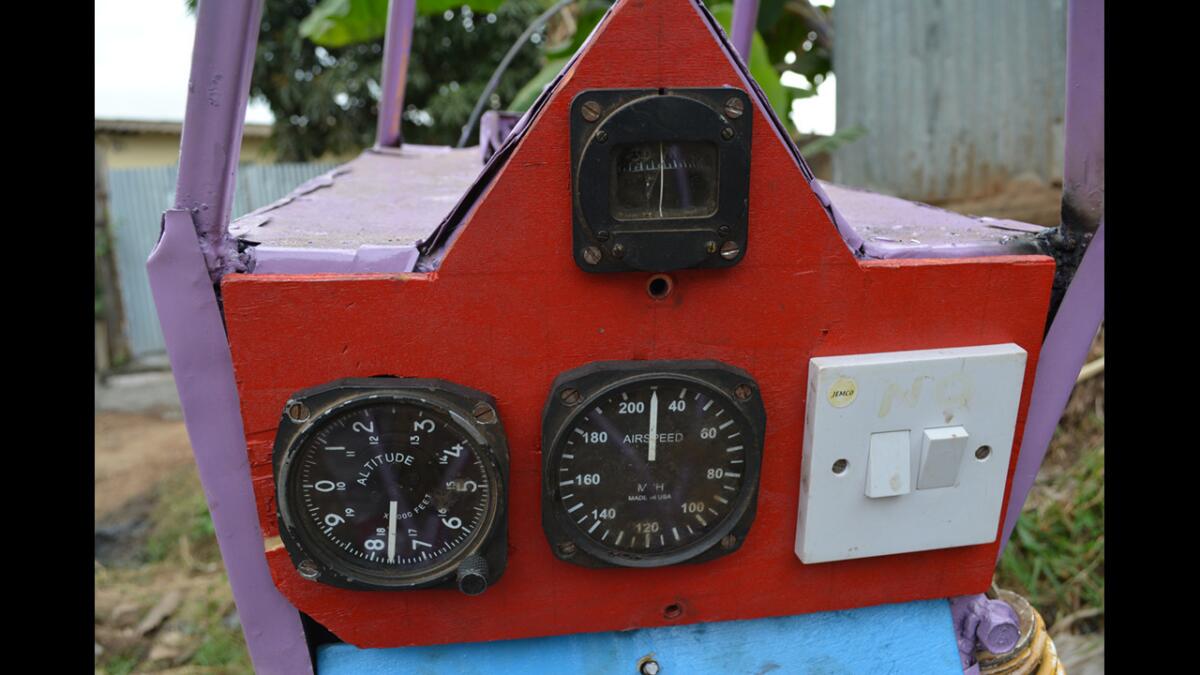
The control panel of Project 14. There have been plenty of flight tests and 13 failures. But this one is going to fly. Gabriel Nderitu just knows it.
Ask him anything about the science of his plane, and Nderitu has a long, detailed and fascinating explanation. But ask him the same question four different ways — why the obsession — and he pauses, gazing thoughtfully into midair.
“Honestly, I’m not able to tell,” he says.
::
To walk into Nderitu’s tiny yard, with its nests of curly aluminum scraps, its tangled heaps of pipe and its discarded piles of spray-paint cans, is to experience real doubt about his crazy project to build his own plane in the suburbs of Nairobi, the Kenyan capital.
If his mind is anywhere near as cluttered as his yard, what hope is there?
The yard, behind a high metal gate in a modest neighborhood, is so small that he can bolt the wings onto the hull only in the street outside. And there are not one but two planes in the yard, and several sets of wings, one shoved onto the roof like a forgotten surfboard.
Nderitu isn’t the first man to try to design and build his own plane or a helicopter in Kenya, where people often have to make things from scratch. The difference is that he is still trying, obsessing over how to shave off a little more weight to get Project 14 into the air, cutting struts out of the wings, scribbling down design modifications and sending them via smartphone to his two full-time welders, whose labor alone costs $500 to $600 a month.
The bumpy rivets and lumpy welding on Project 14 call up a scene in “The Aviator,” when Howard Hughes, played by Leonardo DiCaprio, prowls along a flawless, gleaming steel plane fuselage looking for one shiny rivet not quite flush.
But perfection is not Nderitu’s way. On nights and weekends, he has groped his way along through failures and setbacks sharp enough to make him nearly weep.
His neighbors have politely stopped giving him advice. He hopes it’s because, like him, they expect Project 14 to fly. But in his heart he knows they probably think he’s insane to spend so much time and money on a dream that has never taken off.
“Some people say, ‘Why don’t you buy land? Or a car?’ Even if they didn’t tell you you’re crazy, maybe this is what they think.”
::
Looking back, the Toyota engine in Project One was a mistake.
“Over time one realizes that weight is the biggest enemy of this project,” Nderitu says. “Even moving it was tough. Even lifting that first engine took seven people.” The tires weighed 33 pounds apiece.
Theoretically, some huge wings would fix the weight problem. But then the wings would add even more weight, and already his yard barely held the plane. After three years, Project One ended up as misshapen as an amateur’s clumsy pencil drawing.
“It’s disappointing,” he acknowledges. “You don’t know whether to discard it or to move forward. Any option was expensive.”
But after the humiliation of the half-expected failure of Project One, he says, “I didn’t feel like giving up. I’d invested a lot of time. I knew I could only move onto another project, but not give up.”
Project Two began almost the moment Project One failed, and this time, he designed the planes to be flown by remote control.
His first step was to order a small plane engine from the United States, which cost more than $4,000, including shipping and duty.
“It was painful, because it was expensive, but things moved very quickly from there. One big hurdle was removed.”
Projects Two through 13 came and went with test after test, failure after failure. There were vibrating propellers, wing problems, weight setbacks, welding struggles. He abandoned his hand-carved wooden propellers and imported a light American propeller at a cost of $1,500.
His test of Project 13, in late June, was devastating. The plane gained speed, mounted a small ramp built to give it a lift and crashed to the ground, in an event filmed by a Kenyan TV crew. The propeller smashed to pieces.
“I felt like crying,” Nderitu says. “The victim of every crash is always the propeller, and it’s very expensive.”
Right now, Nderitu is obsessing about the flight test of Project 14, planned for next week.
Many of his neighbors are skeptical, like Grace Njeri, 24, a chic, smartly dressed student, who thinks he’s wasting his time and money.
“Innovations are good,” she says, “but if they aren’t producing good results, it’s better to move on and try other things rather than wasting money on the same thing for many years.”
But his never-give-up attitude has inspired some, who hope, like he does, that the next test will succeed.
Nearby shopkeeper, Ken Mwirigi, 32, saw one of the planes being tested. It seemed to go well, until the propeller broke.
“I believe Nderitu’s dream will eventually come true some day,” he says.
And Nderitu, perhaps inevitably, feels as if he’s very close.
“You only need to cut a little more weight and you will be off the ground. Today we cut” nearly 41/2 pounds, he says. “You just take one day and take your time and go slowly. As long as you apply your measurements, you’re OK.”
As he makes his way through the yard, stepping between the pieces of metal discarded to make Project 14 lighter, Nderitu’s hope is infectious. If Project 14 gets into the air, it’s really only the beginning. Projects 15 and 16 will be designed to be piloted by him.
Does he know how to fly a plane?
Pause.
“Not exactly,” he confesses. It will cost $7,000 and 90 days to get his private pilot’s license.
“I will deal with that problem when I get there.”
More to Read
Sign up for Essential California
The most important California stories and recommendations in your inbox every morning.
You may occasionally receive promotional content from the Los Angeles Times.
